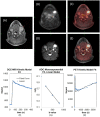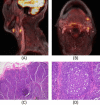Assessment of metastatic lymph nodes in head and neck squamous cell carcinomas using simultaneous 18F-FDG-PET and MRI
- PMID: 33247166
- PMCID: PMC7695736
- DOI: 10.1038/s41598-020-77740-5
Assessment of metastatic lymph nodes in head and neck squamous cell carcinomas using simultaneous 18F-FDG-PET and MRI
Abstract
In this study, we investigate the feasibility of using dynamic contrast enhanced magnetic resonance imaging (DCE-MRI), diffusion weighted imaging (DWI), and dynamic positron emission tomography (PET) for detection of metastatic lymph nodes in head and neck squamous cell carcinoma (HNSCC) cases. Twenty HNSCC patients scheduled for lymph node dissection underwent DCE-MRI, dynamic PET, and DWI using a PET-MR scanner within one week prior to their planned surgery. During surgery, resected nodes were labeled to identify their nodal levels and sent for routine clinical pathology evaluation. Quantitative parameters of metastatic and normal nodes were calculated from DCE-MRI (ve, vp, PS, Fp, Ktrans), DWI (ADC) and PET (Ki, K1, k2, k3) to assess if an individual or a combination of parameters can classify normal and metastatic lymph nodes accurately. There were 38 normal and 11 metastatic nodes covered by all three imaging methods and confirmed by pathology. 34% of all normal nodes had volumes greater than or equal to the smallest metastatic node while 4 normal nodes had SUV > 4.5. Among the MRI parameters, the median vp, Fp, PS, and Ktrans values of the metastatic lymph nodes were significantly lower (p = <0.05) than those of normal nodes. ve and ADC did not show any statistical significance. For the dynamic PET parameters, the metastatic nodes had significantly higher k3 (p value = 8.8 × 10-8) and Ki (p value = 5.3 × 10-8) than normal nodes. K1 and k2 did not show any statistically significant difference. Ki had the best separation with accuracy = 0.96 (sensitivity = 1, specificity = 0.95) using a cutoff of Ki = 5.3 × 10-3 mL/cm3/min, while k3 and volume had accuracy of 0.94 (sensitivity = 0.82, specificity = 0.97) and 0.90 (sensitivity = 0.64, specificity = 0.97) respectively. 100% accuracy can be achieved using a multivariate logistic regression model of MRI parameters after thresholding the data with Ki < 5.3 × 10-3 mL/cm3/min. The results of this preliminary study suggest that quantitative MRI may provide additional value in distinguishing metastatic nodes, particularly among small nodes, when used together with FDG-PET.
Conflict of interest statement
The authors declare no competing interests.
Figures







Similar articles
-
Diffusion-Weighted Imaging (DWI) derived from PET/MRI for lymph node assessment in patients with Head and Neck Squamous Cell Carcinoma (HNSCC).Cancer Imaging. 2020 Aug 8;20(1):56. doi: 10.1186/s40644-020-00334-x. Cancer Imaging. 2020. PMID: 32771060 Free PMC article.
-
Noninvasive assessment of tumor microenvironment using dynamic contrast-enhanced magnetic resonance imaging and 18F-fluoromisonidazole positron emission tomography imaging in neck nodal metastases.Int J Radiat Oncol Biol Phys. 2010 Aug 1;77(5):1403-10. doi: 10.1016/j.ijrobp.2009.07.009. Epub 2009 Nov 10. Int J Radiat Oncol Biol Phys. 2010. PMID: 19906496 Free PMC article.
-
[18F]FDG PET/MRI versus contrast-enhanced MRI in detecting regional HNSCC metastases.Ann Nucl Med. 2021 Feb;35(2):260-269. doi: 10.1007/s12149-020-01565-5. Epub 2021 Jan 17. Ann Nucl Med. 2021. PMID: 33454923
-
Diagnostic accuracy of F-18 FDG PET or PET/CT for detection of lymph node metastasis in clinically node negative head and neck cancer patients; A systematic review and meta-analysis.Am J Otolaryngol. 2019 Mar-Apr;40(2):297-305. doi: 10.1016/j.amjoto.2018.10.013. Epub 2018 Oct 23. Am J Otolaryngol. 2019. PMID: 30473166
-
Diagnostic Accuracy of [18F]FDG PET/MRI in Head and Neck Squamous Cell Carcinoma: A Systematic Review and Metaanalysis.J Nucl Med. 2024 Oct 1;65(10):1533-1539. doi: 10.2967/jnumed.124.268049. J Nucl Med. 2024. PMID: 39266291
Cited by
-
The role of magnetic resonance imaging and computed tomography in oral squamous cell carcinoma patients' preoperative staging.Front Oncol. 2023 Mar 7;13:972042. doi: 10.3389/fonc.2023.972042. eCollection 2023. Front Oncol. 2023. PMID: 36959788 Free PMC article.
-
PET/MR for predicting extranodal extension of head and neck cancer.Neuroradiology. 2025 May 21. doi: 10.1007/s00234-025-03635-9. Online ahead of print. Neuroradiology. 2025. PMID: 40397135
-
Comparable Accuracy of Quantitative and Visual Analyses of [18F]FDG PET/CT for the Detection of Lymph Node Metastases from Head and Neck Squamous Cell Carcinoma.Diagnostics (Basel). 2023 Aug 10;13(16):2638. doi: 10.3390/diagnostics13162638. Diagnostics (Basel). 2023. PMID: 37627898 Free PMC article.
-
T1 mapping for Head and Neck Cancer Patients undergoing Chemoradiotherapy: Feasibility of 3D Stack of Star Imaging.Magn Reson Imaging. 2024 Oct;112:38-46. doi: 10.1016/j.mri.2024.04.005. Epub 2024 Apr 9. Magn Reson Imaging. 2024. PMID: 38604349
-
Simultaneous multislice diffusion-weighted imaging versus standard diffusion-weighted imaging in whole-body PET/MRI.Eur Radiol. 2023 Apr;33(4):2536-2547. doi: 10.1007/s00330-022-09275-4. Epub 2022 Dec 3. Eur Radiol. 2023. PMID: 36460925
References
Publication types
MeSH terms
Substances
Grants and funding
LinkOut - more resources
Full Text Sources
Medical

